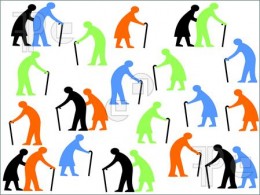Over the past decade, academic researchers such as Oatley and Raymond Mar from York University have gathered data indicating that fiction-reading activates neuronal pathways in the brain that measurably help the reader better understand real human emotion — improving his or her overall social skillfulness. For instance, in fMRI studies of people reading fiction, neuroscientists detect activity in the pre-frontal cortex — a part of the brain involved with setting goals — when the participants read about characters setting a new goal. It turns out that when Henry James, more than a century ago, defended the value of fiction by saying that "a novel is a direct impression of life," he was more right than he knew.
In one of Oatley and Mar's studies in 2006, 94 subjects were asked to guess the emotional state of a person from a photograph of their eyes. "The more fiction people [had] read," they discovered, "the better they were at perceiving emotion in the eyes, and...correctly interpreting social cues." In 2009, wondering, as Oatley put it, if "devouring novels might be a result, not a cause, of having a strong theory of mind," they expanded the scope of their research, testing 252 adults on the "Big Five" personality traits — extraversion, emotional stability, openness to experience, agreeableness and conscientiousness — and correlated those results with how much time the subjects generally spent reading fiction. Once again, they discovered "a significant relation between the amount of fiction people read and their empathic and theory-of-mind abilities" allowing them to conclude that it was reading fiction that improved the subjects' social skills, not that those with already high interpersonal skills tended to read more.
Theory of mind, the ability to interpret and respond to those different from us — colleagues, employees, bosses, customers and clients — is plainly critical to success, particularly in a globalized economy. The imperative to try to understand others' points of view — to be empathetic — is essential in any collaborative enterprise.
Emotions also have an impact on the bottom line. A 1996 study published in the journal Training and Development assessing the value of training workers at a manufacturing plant in emotional management skills — teaching employees to focus on how their work affects others rather than simply on getting the job done — found that union grievance filings were reduced by two-thirds while productivity increased substantially. And a study of a Fortune 400 health insurance company conducted by Peter Salovey, a psychology professor at Yale, looked at the correlations between emotional intelligence and salary and found that people rated highest by their peers in emotional intelligence received the biggest raises and were promoted most frequently.
To bring the subject home, think about how many different people you interact with during the course of a given day — coworkers, clients, passing strangers, store clerks. Then think about how much effort you devoted to thinking about their emotional state or the emotional quality of your interaction. It's when we read fiction that we have the time and opportunity to think deeply about the feelings of others, really imagining the shape and flavor of alternate worlds of experience. Right now, I'm in the middle of Irene Nemirovsky's posthumously published novel about France's fall to the Nazis in 1940. Her simple sentences sketch a sense of uncertainty, moral ambiguity, and heartbreak — feelings I certainly wouldn't want to dwell on in "real" life, but emotions I'm better off for having taken the time to consider.
But nourishing empathy doesn't require such grimness. And if you want your diet of fiction, as it's shaping your mind to be more emotionally acute, to be specifically relevant to work, there is a body of great literature about business and organizational behavior. For instance, Anthony Trollope's The Way We Live Now, inspired by 19th century financial scandals among the British elite, resonates powerfully today. In his autobiography, Trollope wrote that "a certain class of dishonesty, dishonesty magnificent in its proportions, and climbing into high places, has become at the same time so rampant and so splendid that there seems to be reason for fearing that men and women will be taught to feel that dishonesty, if it can become splendid, will cease to be abominable. If dishonesty can live in a gorgeous palace with pictures on all its walls, and gems in all its cupboards, with marble and ivory in all its corners, and can give Apician dinners, and get into Parliament, and deal in millions, then dishonesty is not disgraceful, and the man dishonest after such a fashion is not a low scoundrel. Instigated, I say, by some such reflections as these, I sat down in my new house to write The Way We Live Now." Seems fairly au courant to me.
From now on, I'm going to feel less like an escapist slacker when I'm engrossed in a new novel. In addition to the Trollope, below are some of my favorite books to get you started.
Kurt Andersen, Turn of the Century — set in 2000 and 2001, a successful TV producer husband and digital entrepreneur wife, trying to balance the demands of work and life, wind up pitted against each other as executives in a U.S. media empire. His mistrust grows when she becomes a favorite of the Rupert Murdoch-like chairman. Meanwhile, their hedge-fund-manager best friend is involved in big-time stock manipulation. (Full disclosure: my husband is the author)
Jane Austen, Sandition — in this unfinished fragment of a novel, Austen departs from her typical marriage plot to describe the zealous entrepreneurialism of a real estate speculator. While we can never know how the novel would have ended, we can be pretty sure his housing bubble will burst.
Charles Dickens, Bleak House — Dickens' tenth novel explores the human cost of prolonged litigation through the eyes of Esther Summerson, who is caught up in a multi-generational dispute over the disposition over an inheritance. Anyone who has ever been entangled in a lawsuit will revel in the characterization of the process. At the time of publication, 1852–1853, public outrage over injustice in the English legal system helped the novel to spark legal reform that culminated in the 1870s.
William Gaddis, JR — in the 1976 National Book Award winner, the 11-year old protagonist, JR, secretly trades penny stocks, using the tools of the trade at the time — money orders and payphones — to build a fortune. Written entirely in dialogue, the absurdity of a precocious child's feat satirizes as Gaddis put it, "the American dream turned inside out." His description of dysfunctional boards and the corrosive effect of corporate takeovers and asset stripping are as current today as they were 30 years ago.
Joseph Heller, Something Happened — Heller's stream of consciousness second novel follows a regular-joe middle manager as he prepares for a promotion. The messy interweaving of his thoughts about his job, family, sex, and childhood perfectly distill how complicated the selves we bring to work really are.







